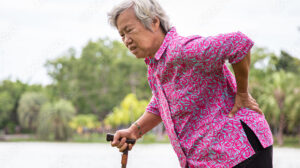The hip joint supports the weight of our body (largest weight-bearing joint in the body) and helps us bend and move without pain. Injury to the hip joint can result in pain, difficulty moving, and the inability to enjoy normal daily activities.

Anatomy of the hip joint
The hip joint is like a ball and socket type joint – the head of the femur (thigh bone) fits in the socket of the pelvis. There are strong ligaments that surround the hip joint to form a capsule and provide stability to the joint. The capsule contains fluids that lubricate the hip joint and allow the joint to move without wear and tear. The muscles of the thigh and lower back provide stability to the hip joint, and the muscles of the hip provide movement to the hip joint (bend, straighten, move sided to side, and turn in an out). There are sacs filled with fluid, called bursa that provide “cushioning” at the front, side, and back of the hip joint. Nerves from the low back give information to the muscles of the hip and provide sensation to the hip, buttock, and thigh region.
Five common causes of hip joint pain
- Hip joint osteoarthritis: This condition is a wear and tear injury of the hip joint cartilage, and develops gradually over time. Typical symptoms of hip osteoarthritis include:
- Achy and stiff hip joint
- Pain is worse after moderate activity and better after rest
- Pain is worse in the morning, and eases during the day after “warming up the joint”
- Limited movements of the hip and leg, walking with a limp, pain getting up from your seat
- Crackling noises in the hip
- Hip bursitis: The bursa is a fluid-filled sac that functions as a cushion between muscles, tendons, ligaments and the hip joint. Bursitis is the irritation or inflammation of the bursa. This condition can be caused by trauma from an accident or repetitive stress. Typical symptoms of hip bursitis include:
- Pain with walking or running
- Tenderness and swelling at the hip joint
- Hip that feels “weak”
- Pain lying down on the sore hip
- Pain getting out of a bed or a chair
- Hip muscle, ligament, and tendon injury: The hip joint is surrounded by large muscles that provide movement and stability. The muscles commonly involved in hip injuries are the hamstrings (back of the thigh), quadriceps (front of the thigh), groin (inner thigh), gluteal (buttock), and hip flexor muscles. Overuse, repetitive use, or trauma from an accident can lead to injury of the muscles, ligaments, or tendons of the hip. A groin pull is an example of a hip muscle injury. Typical symptoms of soft tissue injuries to the hip include:
- Difficulty walking, running, jumping, and climbing stairs
- Difficulty rising from a seated position
- Walking with a limp
- Muscle spasms
- Hip joint swelling
- Muscle weakness
- Low back injuries: Low back muscle or joint injuries can send pain or refer pain to the hip joint, causing sharp or burning pain, and difficulty walking sand standing.
- Nerve injuries: There are several nerves involved with the hip joint, including the sciatic nerve and the femoral nerve. Injury to these nerves can result in pain or numbness around the hip joint. Injury can occur from trauma to the hip, pelvis, and low back. Nerve problems can also occur from seatbelt injuries in a car accident, or even wearing tight clothing or belts at the hip.

Treatment
The first goal before therapy is to diagnose the cause of the pain. In addition to a physical assessment, your chiropractor or family physician may also refer you for special tests such as x-rays, ultrasounds, CT or MRI studies to rule out other serious conditions that can also cause hip joint pain. Your rehabilitation program may include:
- Chiropractic treatments and manual therapies to improve flexibility, balance, and strength of the hip joint. Laser therapy may help reduce the pain associated with the muscle and joint injuries. Massage, physiotherapy, and acupuncture are complimentary therapies that can reduce pain as you become more active.
- Exercise modification: You may need to replace activities such as running, aerobics, and contact sports with low intensity activities such as swimming, biking, and yoga.
- Lifestyle changes: Just as stretching, strengthening, and exercise is important, do not forget to rest the joint and allow it to recover from your daily activities. Monitoring your weight is also important as a few extra pounds can cause an increase in hip joint pain.
- Posture. Education on proper standing, lifting, bending, sitting, and lying techniques to reduce hip joint irritation is important. Proper footwear and proper foot mechanics can help reduce the intensity of hip pain. Custom foot orthotics or over-the-counter foot supports can provide extra cushioning support for your shoes which will reduce stress on the hip joints. If you have chronic hip pain and are limping, you may be prescribed a cane or walker.
Dr. Virginia Nsitem is a chiropractor specializing in laser therapy for spine, muscle, joint, and nerve injuries, and is a Fellow of the Royal College of Chiropractic Sports Sciences in Canada. She may be reached at (905) 275-4993, or by email at totalhealth@bellnet.ca
Stop the Pain … Before the Pain Stops You!


